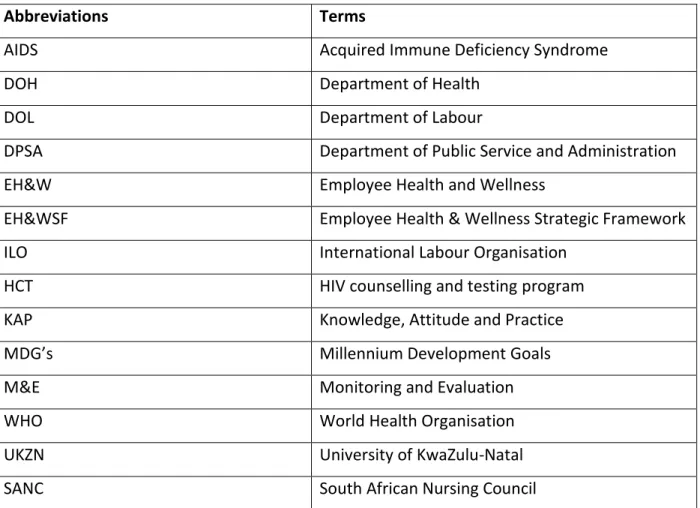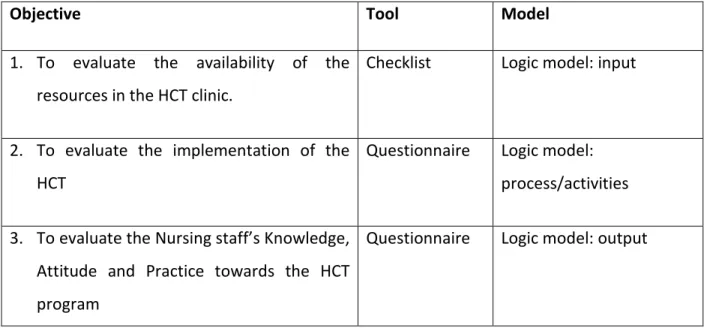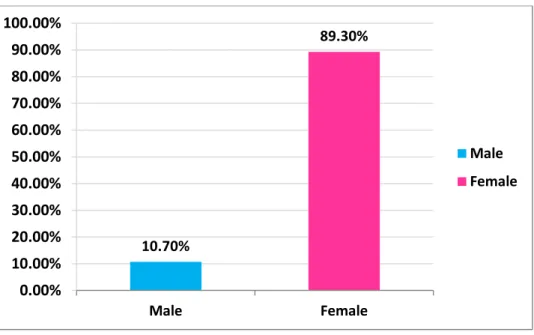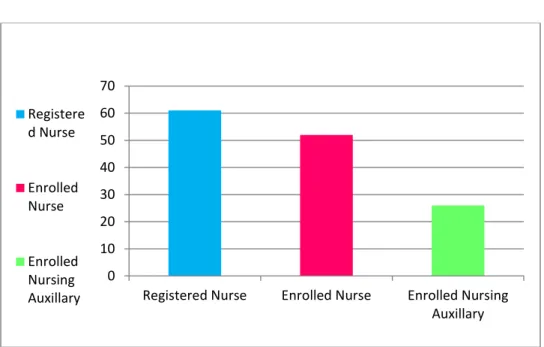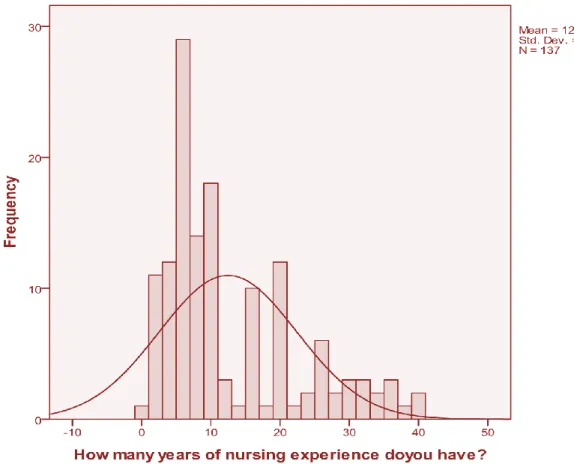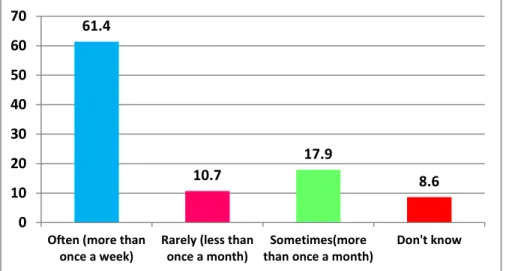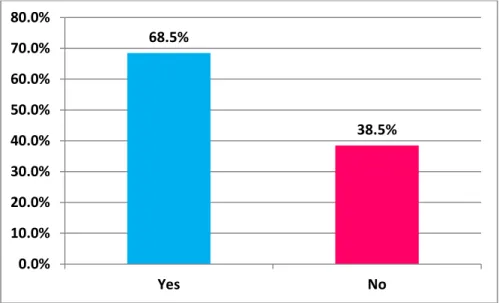COUNSELING AND TESTING (HCT) PROGRAM FOR EMPLOYEES AT SELECTED PUBLIC HOSPITAL IN KWAZUL - NATAL (KZN). A site checklist was also developed to assess the resources available at the HCT clinic.
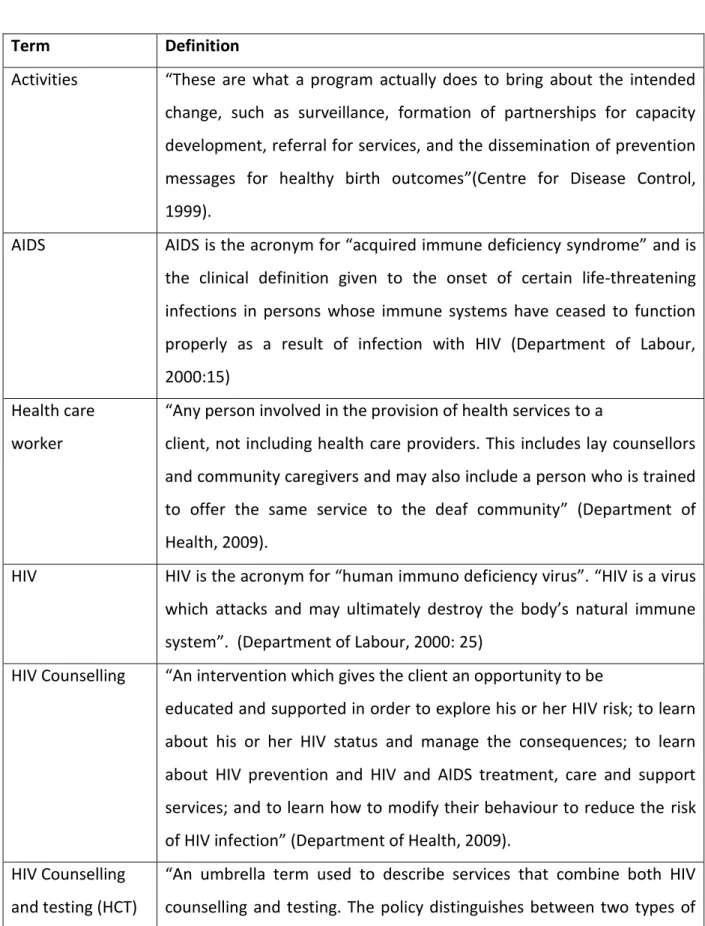
Introduction
Background
A process evaluation of the implementation of the HIV Counseling and Testing program for this group of professionals is therefore crucial in South Africa's quest to reverse these negative trends. This concerned the researcher, who therefore decided to conduct a process evaluation of the implementation of the HIV Counseling and Testing Program for the nursing component of healthcare workers.
Description of the HIV Counselling and Testing Program for Employees
Nurses are the backbone of the health care system, but if the nurses themselves get HIV, who will take care of the rest of the population. 4 According to the Department of Health, HIV Counseling and Testing for staff is the entry point for the continuum of prevention, treatment, care, support and well-being for patients affected by HIV/AIDS.
Purpose of the HIV Counselling and Testing Program for Employees
The most important goal of the HIV counseling and testing program is for staff to improve their knowledge of their HIV status through these services. This staff program is a key element in increasing HIV/AIDS awareness to reduce transmission and improve early access to care and treatment.
The Overall Aim of the HIV Counselling and Testing Program for Employees
Objectives of the HIV Counselling and Testing Program for Employees
Describe different types of HIV counseling and testing approaches for different circumstances and target groups. Expand access to HCT beyond formal health care settings in the community, private sector and non-health care settings.
Activities of the HIV Counselling and Testing Program for Employees
The Monitoring and Evaluation Framework of the HIV Counselling and Testing Program
Research Framework
- Step 1: Describe the Program
- Step 2: Create a Logic Model
- Step 3: Focus the evaluation design
- Step 4: Select Indicators
- Step 5: Gather and Analyse Data
- Step 6: Communicate and Utilise Findings
An evaluation of results can be described as the (sequence of) proposed changes that occur as a result of program activities. Outcome evaluations should not be made until a process evaluation has been conducted to determine whether the program has in fact been implemented and operated according to its stated objectives.
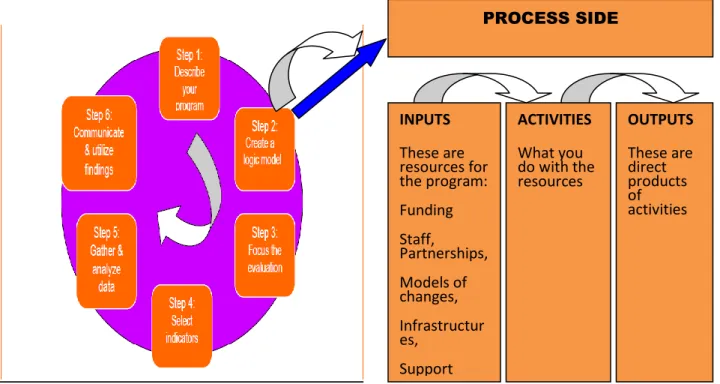
Problem Statement
A process evaluation is also underway, while an outcomes evaluation is only done after we know that the program has been implemented and is running; to determine if the program is effective. Stigma and discrimination are considered major obstacles to the successful implementation of the HIV counseling and testing workplace programs (Mahajan, Colvin, Rudatsikira & Ettl, 2007:31; and the Population Council, 2002:1).
Significance of the Study
One of the key challenges facing the Civil Service relates to HIV/AIDS education and prevention programs which need to receive solid, sustained support and become more rigorous and strategic (Department of Health, 2008:21). 13 Area of practice: The study will help managers in the Department of Health to recognize and take into account the strengths and weaknesses of the program.
Relevance of the Study to South Africa
Rationale
Aims and Objectives of the Study
Aim
Objectives
Research questions
Introduction
Workplace prevention programs are essential to combat the spread of HIV and to promote greater tolerance for people living with HIV/AIDS. Sub-Saharan Africa is the region most affected by HIV/AIDS (UNAIDS, 2010:9) and accounts for 68% of the global incidence of HIV, with various generalized HIV epidemics disproportionately affecting women and young people (especially young women) .
The Impact of HIV / AIDS in the Workplace
- Morbidity and Absenteeism
- Mortality or Retirement
- Staff Morale
- Benefits
- Demand for Services
25 are ill and may not want to take on the additional responsibilities of those who are not ill. Department of Public Service and Administration, 2002:15).
HIV / AIDS Legislation
Constitution of the Republic of South Africa Act, No.108 of 1996
Measures to Deal with HIV / AIDS within the Workplace
Employee Wellness Program
Management of HIV in the Workplace
Effective management of HIV/AIDS in a workplace requires an integrated strategy for assessing the impact of HIV/AIDS in the workplace and ways to reduce and manage this impact. These measures include a workplace HIV/AIDS policy and HIV/AIDS programs that incorporate the ongoing ongoing prevention of the spread of HIV among employees and their communities; managing employees with HIV so that they are able to work productively for as long as possible; and strategies to address the direct and indirect costs of HIV/AIDS in the workplace.
Organisational Wellness
This then led to the creation of an HIV counseling and testing policy and programme. HIV and AIDS are referred to as part of a wellness program or wider staff development program (Ministry of Health, 2008b:44).
HIV / AIDS Workplace Programs
There is a strong demand for each workplace to develop their respective HIV/AIDS policy and ultimately implement HIV/AIDS program to mitigate the impact of the epidemic. Develop strategies to address the direct and indirect costs associated with HIV/AIDS in the workplace; and regularly monitor, evaluate and review the workplace HIV/AIDS programme”.
Prevention Programs
Rationale
Organize regular HIV/AIDS awareness programs; Encourage HIV testing; Provide information and training on HIV/AIDS; Promote the distribution and use of condoms; Maximize the performance of HIV-affected employees through reasonable accommodations, such as exploring alternative sick leave allocations;
Summary of Prevention Elements
Wellness Programs
32 wellness program should meet the needs of all employees, including those who are HIV negative but at risk, those who are HIV positive but asymptomatic, those in early and late stages of HIV, and those who are terminally ill.
HIV / AIDS Education and Training
Communication Strategies
Ensuring that employees and employers are aware of the HIV/AIDS policy and program and understand what it can offer them. Giving all staff an opportunity to provide input and contribute to the development, maintenance and review of the HIV/AIDS policy and program (Department of Public Service and Administration.
Reporting, Monitoring and Evaluation
Evaluation Research
33 problems such as low utilization of the services offered by the program; and the fact that both management and staff are not committed to the policy and program as they are unaware of developments and feel excluded from the process.
Process Evaluation
The purpose of a monitoring and evaluation component of a workplace HIV/AIDS prevention program is to chart the progress of the program and ensure that it is achieving its stated objectives. Some of the challenges in monitoring and evaluation are the lack of data on the population most at risk.
Evaluating the HIV Counselling and Testing Program
Reporting the monitoring and evaluation findings is an important function of any workplace intervention, but it is often neglected. One of the key aspects of a counseling and testing intervention is the evaluation of the program to determine whether it meets the predetermined protocol and whether it satisfies the clients.
Evaluation Framework
Logic Model
Core Ethical Principals
Risk of Health Care Personnel Contracting HIV
Promoting a safe working environment
The Manifestation of HIV / AIDS Related Stigma and Discrimination in the Workplace
More than 90% of people living with HIV and AIDS live in developing countries, with Sub-Saharan Africa remaining the epicenter of the disease (UNAIDS, 2010: 17). South Africa has 17% of the total number of children and adults worldwide infected with HIV/AIDS.
Attitude towards VCT
It was obvious that health workers would be discriminated against if others found out they were HIV positive. The study's findings suggest that interventions to increase HIV testing in South Africa should address stigma and societal perceptions of testing.
Awareness of HCT
44 test kits and supply of consumables, lack of space and lack of specialized training in facilities were obstacles to the provision of PITC (Kapologwe, Kabengula & Msuya, 2011:17).
Knowledge of HCT
45 Engelsmann, & Dabis reported the findings of a study in the rural part of Zimbabwe that knowledge of HIV was related to VCT uptake in an adult group. In the African studies mentioned above, those with higher educational status were more likely to accept tests; in the present study, education level did not correlate with HIV test results.
Previous workplace initiatives
Findings show increased adoption of counseling, testing, and treatment among health care professionals in all three programs (Uebel, Nash, Avalos, 2007:500). Care and treatment for healthcare workers should be convenient, holistic and integrated in one clinic.
Barriers to testing
It seems very important to deny these notions and restore trust in the health care system. In addition, the study confirmed that participants also doubted the ability of health professionals to perform appropriate testing.
Conclusion
According to Annemarie, Arjan, Hans, Herman, AIDS-related stigma is deeply rooted in South Africa and people are very afraid of being stigmatized. It is important to educate people about AIDS-related stigma and to design theory- and evidence-based interventions to reduce AIDS-related stigma (45-47).
Introduction
Setting
Research Approach
Research Paradigm
Research Design
Population and Sample
Population Sample for Nursing Staff Survey
Research Tools
- The Construction, Testing and Administration of the Questionnaire
- Instrument 1: Checklist of the Venue for Staff HIV Counselling and Testing Clinic
- Instrument 2: Quantitative Questionnaire for Staff employed at the HIV Counselling and Testing
- Instrument 3: Quantitative Questionnaire of KAP for Nursing Staff
- Validity and Reliability of the Evaluation Tools
A quantitative questionnaire was administered to the employees working in the HCT clinic to evaluate the implementation of the HCT program for employees. 53 consisted of a questionnaire which evaluated the implementation of the HCT activities for employees of the selected public hospital in KwaZulu-Natal.
Data Collection Procedure [Step 5 (Gather Credible Evidence)]
- Checklist for the HCT Clinic
- Quantitative Questionnaire for Staff employed at the HIV Counselling and Testing Clinic
- Quantitative Questionnaire of KAP for Nursing Staff
- Data Analysis, Utilisation and Communication
The research assistant administered the questionnaire to each participant, along with a cover letter explaining the purpose and background of the study. The quantitative questionnaire was given to the employees employed at the HCT clinic, who are involved in the actual counseling, testing and referrals of the patient for completion.
Ethical Issues
Informed consent: Participants were given information leaflets to read and keep, which contained information about the background of the study and how the collected data were used. The participants were informed about the results of the study and a copy was released on the site.
Data Dissemination
The results of the study will be published in a thesis and in an accredited SAPSE nursing journal without revealing the identification of the participants or the organization in which the study was conducted. An information guide with the name, telephone numbers and address of the researcher and the UKZN Ethics Committee was provided to participants if any of the participants had any questions about the study.
Limitations of the Study
Participants were assured that they could withdraw at any time without penalty and no questions asked. Additionally, confidentiality was guaranteed because the data collected were stored in locked cabinets at the School of Nursing at the University of KwaZulu-Natal, where only the researcher and supervisor had access to the data.
Introduction
Data Analysis and Interpretation
If the p-value is greater than 0.05, the study's findings are considered statistically insignificant at that level. This chapter consists of four (4) components: Section A represents the socio-demographic data of the sample; Part B presents the findings of instrument one, i.e.
Section A: Socio-demographic Data
- Age of Respondents
- Gender
- Highest Level of Education of Employees at the Selected Hospital
- Designation of Nurses
- Years of Nursing Experience
- Did You Attend an HIV/AIDS Course?
- How Often Do You Care For Patients With HIV / AIDS?
- Are You Interested in Attending an HIV/AIDS Course at the Workplace?
- I Am Aware That the Hospital Has an HCT Clinic
The findings of the study are presented in the bar graph above which shows that in a total sample of 130 participants; 95.5% (n=126) are interested in attending a course on HIV/AIDS in the workplace and only 4.5% (n=6) of respondents stated that they would not wish to attend such a course. Of the participants, 97% (n=128) reported knowing that the hospital had an HCT staff clinic, and only 3% (n=4) reported not knowing.
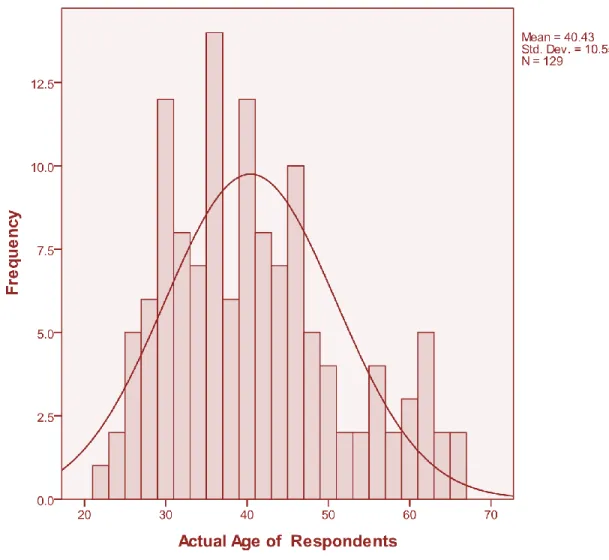
Resources Available at the staff HCT Clinic
From the table itself, it was clear that there are some resources that are available to busy HCT clinicians and some that are not. HIV kits were kept at the clinic but only one (1) was in stock at the time of assessment.
Activities of the HCT Program for Employees
- Frequencies of Trained staff in HIV Counselling and Testing
- Frequencies of Number of Clients Counselled Per Day
- Departments That Clients Are Referred To
- Supervision of HIV Counsellors and Testers
- Frequency distribution of Respondents Access to the Following Items
There were no directions to the HCT clinic and condoms, pamphlets, and reading materials were not available to clients in the HCT clinic at the time of the evaluation. The above graph shows the supervision of staff working in the HCT clinic and those involved in HIV/AIDS counselling.
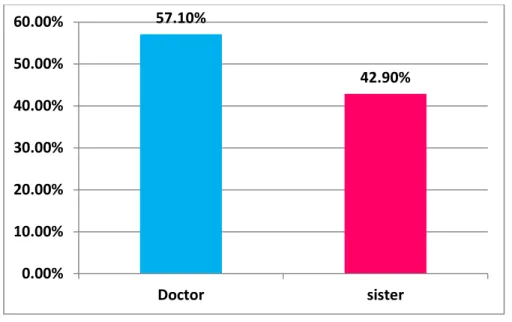
Knowledge, Attitude and Practice of Employees towards the HCT Program
- Knowledge of the HCT Program by the Participants
- A Graph Summarising Awareness of the HCT Program by the Respondents
- Services Offered as Part of the HCT Program
- Implementation of Condom Promotion Activities
- Attitude of Nurses Regarding the HCT Program
- Practise of Nurses Regarding the HCT Program
This is considered a negative attitude towards the HCT program because if nurses fear that staff will discriminate against them if they find out they are HIV positive, it is likely that these staff will not use the HCT clinic. Participants' attitude toward the HCT program for hospital staff was assessed using a 5-point Likert scale of strongly agree, agree, neutral, disagree, and strongly disagree.
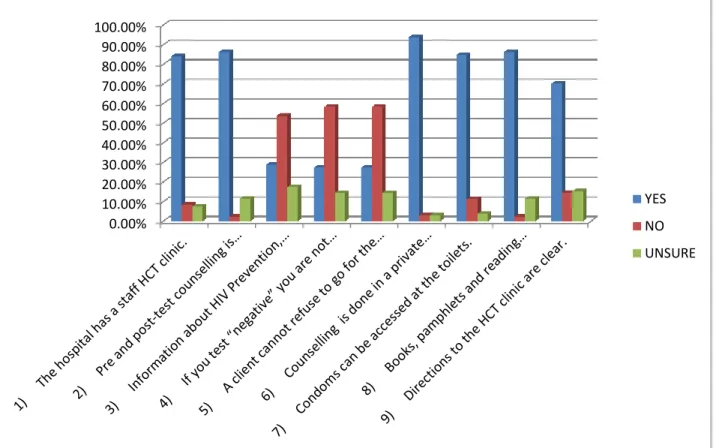
Correlation of Knowledge and Attitude of Those That Attended the HIV Course Compared To
Correlation between knowledge and attitudes of those who completed the HIV course compared to those who did not attend the HIV course. An independent Mann Whitney U test was administered to assess the knowledge of nurses who had completed an HIV/AIDS course and those who had not.
Correlations Between Nurses Knowledge And Attitudes
The level of significance was 0.05 with a p-value of 0.65, which indicated that the distribution of knowledge was the same for all categories of nurses. The findings show that the distribution of knowledge is the same across all categories of the highest level of education.
Knowledge and Attitude Compared To Years of Experience
The findings showed that there was a significant p value of 0.031, indicating that nurses' attitudes were influenced by their years of experience. This shows that the knowledge of nurses is not affected by their many years of experience.
Conclusion
The researcher initially hypothesized that the more experienced the nurse, the greater her knowledge and better attitude, as the respondent is exposed to the HCT program for a much longer time. An independent sample Kruskal-Wallis test was conducted to determine whether nurses' knowledge was influenced by their years of experience.
Introduction
Discussion of Findings
- Nurses demographic data
- Resources Available At the HCT Clinic
However, the research findings show that most of the nurses employed in the selected public hospital are aware of the HCT program for employees. There were some resources that were available at the employee HCT clinic and some that were not.
Activities of the HCT Program for Employees
Knowledge, Attitude and Practice of Employees towards the HCT Program
- Knowledge of HCT Program by the Respondents
- Attitude of Nurses Regarding the HCT Program
- Practise of Nurses Regarding the HCT Program Percentage Distribution
- Correlation Tests
The findings of this research show that the majority of respondents have taken the HIV test voluntarily and received their results. Based on the findings of the study, the attitude of nurses is not affected by the level of education of the nurse.
Conclusion
There was also no significant difference in the attitude of nurses and the level of education. The findings also indicate that nurses' knowledge is not influenced by their years of experience.
Recommendations
- Recommendations for practice
- Recommendations for education
- Recommendations for research
- Recommendations for management
The results of the survey revealed that there was a lack of resources at the HCT clinic for staff. The researcher recommends that antiretroviral treatment (ART) be made available to employees at the HCT clinic.
Limitations of the Study
Verbal and physical abuse and neglect as manifestations of HIV/AIDS stigma in five African countries. Caring for caregivers: Models of HIV/AIDS care and treatment for health workers in southern Africa.
Research tools
Checklist for the venue
108 PROCESS EVALUATION OF THE IMPLEMENTATION OF A HEALTH COUNSELING AND TESTING (HCT) PROGRAM FOR EMPLOYEES AT A SELECTED PUBLIC SECTOR HOSPITAL IN KWAZULU - NATAL.
QUESTIONNAIRE: To Be Administered To Staff That Work at the HCT Clinic to
Evaluating the Knowledge, Attitude and Practice of Nurses Regarding the HCT
Assessing nurses' attitudes towards a staff HCT program in a selected hospital. Evaluation of nurses' practice regarding a staff HCT program in a selected hospital.
Ethical clearance from UKZN
Ethical approval from Department of Health
Letter of approval by the Hospital Ethics committee
LETTER TO THE HOSPITAL CEO
LETTER TO THE NURSING SERVICE MANAGER
LETTER TO THE PROVINCIAL DOH
LETTER OF INVITATION AND INFORMED CONSENT
The researcher did not see or foresee any risks during the duration of the study. Practice Area: The study will help managers in the Ministry of Health to identify and consider the strengths and weaknesses of the program.
